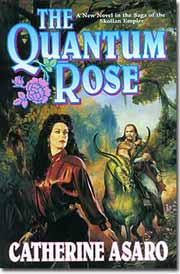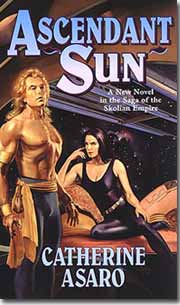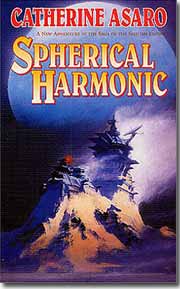Catherine Asaro
 Former physics professor Catherine Asaro is a rising star among science fiction authors. Her books range from ‘hard’ science fiction, with scientific plot devices and premises laid out in intricate detail, to softer science fiction novels that use futuristic technology as a kind of backdrop to character-driven plots. Arguably, her best work includes a substantial dose of hard science fiction in addition to well-developed, interpersonal relationships. In fact, the characters in her science fiction books occasionally have relationships that are, to say the least, steamy. “Traditionally, you couldn't write intimate scenes in science fiction. You just turned the lights out,” says Asaro. “Well, you don't have to turn the lights out anymore.” A few well-lit boudoir scenes certainly haven’t hurt her book sales. Asaro’s novels and short stories seem to appeal to both hard-core science fiction fans and to romance fiction fans. “Romance,” Asaro explains, “is just a kind of code word for intimate scenes. I write about science in the future -- about how it affects people and relationships. And that includes how we love each other. Most romance readers would probably say that I write science fiction with romantic aspects to it.” In 2001 Asaro received the Nebula Award, one of science fiction's most prestigious prizes, for Quantum Rose even though it is one of her softer science fiction works.
Former physics professor Catherine Asaro is a rising star among science fiction authors. Her books range from ‘hard’ science fiction, with scientific plot devices and premises laid out in intricate detail, to softer science fiction novels that use futuristic technology as a kind of backdrop to character-driven plots. Arguably, her best work includes a substantial dose of hard science fiction in addition to well-developed, interpersonal relationships. In fact, the characters in her science fiction books occasionally have relationships that are, to say the least, steamy. “Traditionally, you couldn't write intimate scenes in science fiction. You just turned the lights out,” says Asaro. “Well, you don't have to turn the lights out anymore.” A few well-lit boudoir scenes certainly haven’t hurt her book sales. Asaro’s novels and short stories seem to appeal to both hard-core science fiction fans and to romance fiction fans. “Romance,” Asaro explains, “is just a kind of code word for intimate scenes. I write about science in the future -- about how it affects people and relationships. And that includes how we love each other. Most romance readers would probably say that I write science fiction with romantic aspects to it.” In 2001 Asaro received the Nebula Award, one of science fiction's most prestigious prizes, for Quantum Rose even though it is one of her softer science fiction works.
Asaro enjoys exploring the details of the scientific elements in her stories. Many of her books document the adventures of various members of the Ruby Dynasty, who rule the galactic Skolian Empire. “You can't have a galactic empire without a way to go faster than the speed of light,” says Asaro. “So I wanted to come up with a believable way to do it, even if it's not physically possible.” The solution Asaro found was a mathematical trick involving imaginary numbers. “It's as if you're traveling in the complex plane,” she explains, “It's actually kind of simple, and it's pretty.” In fact, discovery of the trick led Asaro to publish a paper in the American Journal of Physics entitled “Complex Speeds and Special Relativity,” (Am. J. Phys, 64 (4), April 1996, 421). Asaro chuckles, “I even included a question about it on one of my exams when I was teaching physics at Kenyon College.”
In the novel Primary Inversion, a fictional sub-electronic particle Asaro invented becomes an important plot device. “I gave all the details of a weapon that uses the antiparticle; like the magnetic field and the radius of curvature of this miniature particle accelerator. Then I described what would happen when the anti-particle annihilated matter. I actually have readers who will go through all that and check to see if my numbers are right,” says Asaro. “At times, I think I include a bit too much of the science. It's great for the readers who like to work out that stuff. Others write to me to say they loved the story, but that they just skipped over all the scientific exposition.”
Like her novels, Asaro's personal life is a successful blend of traits that at first might seem mutually exclusive. “I started out majoring in dance,” says Asaro,“because I wanted to be a professional dancer. But I always liked science and math.” She attributes her interest in science in part to her father Frank Asaro, a highly respected chemist at Lawrence Berkeley Laboratory who, among other things, was one of a group of researchers to first propose that the mass extinctions that led to the demise of the dinosaurs sixty-five million years ago may have resulted from a comet or asteroid impact. “Pretty soon I was primarily studying mathematics, chemistry, and mathematical physics.” Asaro eventually completed a Ph. D. in chemical physics at Harvard, although along the way she founded two performance companies, the Mainly Jazz Dancers and the Harvard University Ballet and served as artistic director for both groups.
Asaro now lives in the Maryland suburbs with her husband John, a NASA astrophysicist, and her academically precocious, home-schooled daughter Catherine. In recent years, Asaro has offered her services as a science consultant and even participated in a NASA sponsored program on advanced space propulsion concepts. Lately, however, she has directed most of her professional energy into writing. “I'm very lucky to be able to combine the subjects and issues I love into my writing,” says Asaro, “I don't think there's anything else I'd rather do.”

Asaro’s novel Quantum Rose garnered the 2001 Nebula Award, one of science fiction literature’s most prestigious awards. Cover illustration by Julie Bell.

Ascendant Sun is a critically acclaimed installment in Asaro’s ongoing tale of the Ruby Dynasty. The cover art is a nod to classic pulp science fiction novel illustrations, which often featured a striking female figure at the mercy of a menacing male character. The image on the cover of Ascendant Sun reverses the traditional roles. Cover illustration by Julie Bell.

Unlike many of her earlier novels, Asaro’s latest installment in the saga of the Skolian Empire, Spherical Harmonic, features an unmistakably “hard” science fiction cover. Cover illustration by John Harris.
More information about Catherine Asaro, including a bibliography, book excerpts and reviews, and a list of her upcoming public appearances, is available on her website www.sff.net/people/asaro. Asaro's Photo by Hugh Talman











